【降雨带动微生物扩散】Young Soo Joung, Zhefei Ge, Cullen R. Buie. Bioaerosol generation by raindrops on soil. Nature Communications 8, Article number: 14668 (2017)
美国麻省理工学院的Cullen Buie等人本周在《自然-通讯》上发表的论文研究表明:土壤中的细菌可能通过雨滴在空气中扩散。这种新的机制有助于我们了解细菌长距离传播的机理。(来源)
Abstract
Aerosolized microorganisms may play an important role in climate change, disease transmission, water and soil contaminants, and geographic migration of microbes. While it is known that bioaerosols are generated when bubbles break on the surface of water containing microbes, it is largely unclear how viable soil-based microbes are transferred to the atmosphere. Here we report a previously unknown mechanism by which rain disperses soil bacteria into the air. Bubbles, tens of micrometres in size, formed inside the raindrops disperse micro-droplets containing soil bacteria during raindrop impingement. A single raindrop can transfer 0.01% of bacteria on the soil surface and the bacteria can survive more than one hour after the aerosol generation process. This work further reveals that bacteria transfer by rain is highly dependent on the regional soil profile and climate conditions.
【气候变化对农业生产力的影响】Xin-Zhong Lianga,b,1, You Wuc,b, Robert G. Chambersd,1, Daniel L. Schmoldte, Wei Gaof,g,1, Chaoshun Liuh,i, Yan-An Liuh,i, Chao Suna, and Jennifer A. Kennedyb. Determining climate effects on US total agricultural productivity. PNAS, 2017, doi: 10.1073/pnas.1615922114
Abstract
The sensitivity of agricultural productivity to climate has not been sufficiently quantified. The total factor productivity (TFP) of the US agricultural economy has grown continuously for over half a century, with most of the growth typically attributed to technical change. Many studies have examined the effects of local climate on partial productivity measures such as crop yields and economic returns, but these measures cannot account for national-level impacts. Quantifying the relationships between TFP and climate is critical to understanding whether current US agricultural productivity growth will continue into the future. We analyze correlations between regional climate variations and national TFP changes, identify key climate indices, and build a multivariate regression model predicting the growth of agricultural TFP based on a physical understanding of its historical relationship with climate. We show that temperature and precipitation in distinct agricultural regions and seasons explain ∼70% of variations in TFP growth during 1981–2010. To date, the aggregate effects of these regional climate trends on TFP have been outweighed by improvements in technology. Should these relationships continue, however, the projected climate changes could cause TFP to drop by an average 2.84 to 4.34% per year under medium to high emissions scenarios. As a result, TFP could fall to pre-1980 levels by 2050 even when accounting for present rates of innovation. Our analysis provides an empirical foundation for integrated assessment by linking regional climate effects to national economic outcomes, offering a more objective resource for policy making.
【长期气候变暖对碳循环变化的影响】Gabriel Yvon-Durocher, Chris J. Hulatt, Guy Woodward & Mark Trimmer. Long-term warming amplifies shifts in the carbon cycle of experimental ponds. Nature Climate Change 7, 209–213 (2017) doi:10.1038/nclimate3229
Abstract
Lakes and ponds cover only about 4% of the Earth’s non-glaciated surface1, yet they represent disproportionately large sources of methane and carbon dioxide2, 3, 4. Indeed, very small ponds (for example, <0.001 km2) may account for approximately 40% of all CH4 emissions from inland waters5. Understanding how greenhouse gas emissions from aquatic ecosystems will respond to global warming is therefore vital for forecasting biosphere–carbon cycle feedbacks. Here, we present findings on the long-term effects of warming on the fluxes of GHGs and rates of ecosystem metabolism in experimental ponds. We show that shifts in CH4 and CO2 fluxes, and rates of gross primary production and ecosystem respiration, observed in the first year became amplified over seven years of warming. The capacity to absorb CO2 was nearly halved after seven years of warmer conditions. The phenology of greenhouse gas fluxes was also altered, with CO2 drawdown and CH4 emissions peaking one month earlier in the warmed treatments. These findings show that warming can fundamentally alter the carbon balance of small ponds over a number of years, reducing their capacity to sequester CO2 and increasing emissions of CH4; such positive feedbacks could ultimately accelerate climate change.
【减少农药施用对农场生产力的影响】Martin Lechenet, Fabrice Dessaint, Guillaume Py, David Makowski & Nicolas Munier-Jolain. Reducing pesticide use while preserving crop productivity and profitability on arable farms. Nature Plants 3, Article number: 17008 (2017) doi:10.1038/nplants.2017.8
Abstract
Achieving sustainable crop production while feeding an increasing world population is one of the most ambitious challenges of this century1. Meeting this challenge will necessarily imply a drastic reduction of adverse environmental effects arising from agricultural activities2. The reduction of pesticide use is one of the critical drivers to preserve the environment and human health. Pesticide use could be reduced through the adoption of new production strategies3,4,5; however, whether substantial reductions of pesticide use are possible without impacting crop productivity and profitability is debatable6,7,8,9,10,11,12,13,14,15,16,17. Here, we demonstrated that low pesticide use rarely decreases productivity and profitability in arable farms. We analysed the potential conflicts between pesticide use and productivity or profitability with data from 946 non-organic arable commercial farms showing contrasting levels of pesticide use and covering a wide range of production situations in France. We failed to detect any conflict between low pesticide use and both high productivity and high profitability in 77% of the farms. We estimated that total pesticide use could be reduced by 42% without any negative effects on both productivity and profitability in 59% of farms from our national network. This corresponded to an average reduction of 37, 47 and 60% of herbicide, fungicide and insecticide use, respectively. The potential for reducing pesticide use appeared higher in farms with currently high pesticide use than in farms with low pesticide use. Our results demonstrate that pesticide reduction is already accessible to farmers in most production situations. This would imply profound changes in market organization and trade balance.
【玉米根系细菌群落】Ben Niua, Joseph Nathaniel Paulsonb,c, Xiaoqi Zhengb,d, and Roberto Koltera,1. Simplified and representative bacterial community of maize roots. PNAS, 2017, doi: 10.1073/pnas.1616148114
Abstract
Plant-associated microbes are important for the growth and health of their hosts. As a result of numerous prior studies, we know that host genotypes and abiotic factors influence the composition of plant microbiomes. However, the high complexity of these communities challenges detailed studies to define experimentally the mechanisms underlying the dynamics of community assembly and the beneficial effects of such microbiomes on plant hosts. In this work, from the distinctive microbiota assembled by maize roots, through host-mediated selection, we obtained a greatly simplified synthetic bacterial community consisting of seven strains (Enterobacter cloacae, Stenotrophomonas maltophilia, Ochrobactrum pituitosum, Herbaspirillum frisingense, Pseudomonas putida, Curtobacterium pusillum, and Chryseobacterium indologenes) representing three of the four most dominant phyla found in maize roots. By using a selective culture-dependent method to track the abundance of each strain, we investigated the role that each plays in community assembly on roots of axenic maize seedlings. Only the removal of E. cloacae led to the complete loss of the community, and C. pusillum took over. This result suggests that E. cloacae plays the role of keystone species in this model ecosystem. In planta and in vitro, this model community inhibited the phytopathogenic fungus Fusarium verticillioides, indicating a clear benefit to the host. Thus, combined with the selective culture-dependent quantification method, our synthetic seven-species community representing the root microbiome has the potential to serve as a useful system to explore how bacterial interspecies interactions affect root microbiome assembly and to dissect the beneficial effects of the root microbiota on hosts under laboratory conditions in the future.








